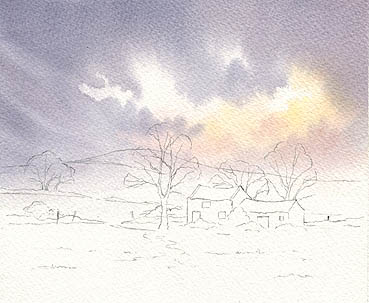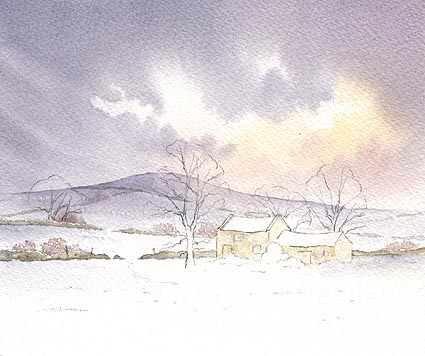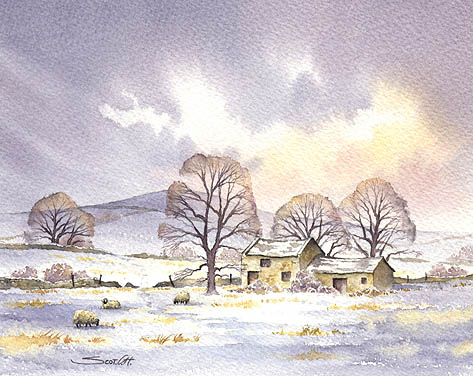 |
|
| "Bakewell Barn", Snow Scene Demonstration | |
|
Painting a snow scene can be a great way of simplifying a scene. Blankets of snow hide excessive detail and can also help to highlight the subject or focal points of a painting. Snow scenes often appear cold and unappealing so unless your goal is to portray a harsh winter environment it may help to soften the conditions. Adding warm colours to your snow scene can be an effective technique for doing this and can help draw the viewer in and make your painting more appealing.
|
|
|
1. The Sky |
|
|
2. Hills and Walls
For the background hill I painted a wash of indigo and alizarin crimson (the same colours that were used in the sky). I kept the left edge of the Hill wash pale as the sweeping snow clouds fade out the detail and emphasise the conditions. The dry stone walls and bushes were suggested using indigo and raw sienna with a splash of alizarin crimson. Notice how the walls are broken here and there to suggest snow drifts and gaps. Try to avoid painting dry stone walls perfectly straight as this can make your painting look unnatural. The barn walls were also painted with a mixture of raw sienna and indigo with a drop of burnt sienna and Naples yellow. Detail was left to a minimum with only the suggestion of sandstone blocks here and there.
|
|
|
3.
The trees were painted with a mixture of indigo and light red using a rigger. A light wash of colour was added to the outside edges of the tree branches. I used these brighter colours to soften the trees as well as to add contour and balance to the branches. This simple technique can help your trees look less like spiky porcupines. I kept the foreground simple using the colours indigo, alizarin crimson (the same colours that I used for the background hill) and a little French ultramarine. Finally I used a fine sable brush with raw sienna, burnt sienna and a little Naples yellow to suggest the grass and sheep. The sheep were an afterthought and help to add interest to the painting. |
|
| All images on this site are copyright | contact scot@barnstudio.com |
 First
I applied a mixture of alizarin crimson and Naples yellow to the
horizon line above the barn. Appling the warm colours here helps
to highlight the focal point of the painting; the barn. I
allowed this wash to dry. You can speed the drying process by
using a hairdryer (be gentle as you donít want to blow the
pigment across the paper). For the snow clouds in the sky I
created a mixture of Alizarin crimson and indigo. Before adding
the dark cloud wash I gently applied a clear wash of water over
the entire top portion of the sky. You want the paper to be damp
not saturated. I then applied the sky mixture and allowed it to
spread. I gave a hard edge to some of the clouds by gently
lifting some of the pigment with a tissue. The sweeping breaks
in the cloud to the left of the hill were created by gently
lifting some of the wash with a flat brush while the sky mixture
was still damp on the paper.
First
I applied a mixture of alizarin crimson and Naples yellow to the
horizon line above the barn. Appling the warm colours here helps
to highlight the focal point of the painting; the barn. I
allowed this wash to dry. You can speed the drying process by
using a hairdryer (be gentle as you donít want to blow the
pigment across the paper). For the snow clouds in the sky I
created a mixture of Alizarin crimson and indigo. Before adding
the dark cloud wash I gently applied a clear wash of water over
the entire top portion of the sky. You want the paper to be damp
not saturated. I then applied the sky mixture and allowed it to
spread. I gave a hard edge to some of the clouds by gently
lifting some of the pigment with a tissue. The sweeping breaks
in the cloud to the left of the hill were created by gently
lifting some of the wash with a flat brush while the sky mixture
was still damp on the paper.
 Trees
and Foreground
Trees
and Foreground